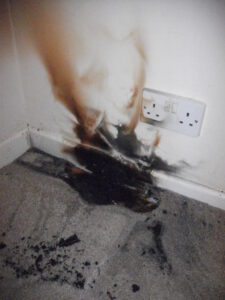Today we're going to talk about how you can reduce the fire risks from your mobile devices. It was interesting to read a few months back about the recent development of a lithium-ion battery with a built in fire extinguisher. Lithium-ion batteries are used to power many mobile gadgets and have been the subject of increasing safety scrutiny particularly since the very high profile problems experienced by Samsung with their Galaxy Note 7 model exploding and catching fire.
In the case of the Note 7, where both the original then the replacement batteries were at fault, the problems stemmed from fundamental design flaws and incorrect manufacturing. But sometimes it only takes an isolated incident, like dropping the phone, to damage the battery which then increases the risk. If a battery’s damaged it can short circuit, expand and potentially explode. Devices are more vulnerable when they’re charging too as the process creates heat.
4 ways to reduce the fire risks
Leaving a device charging unattended is risky. Leaving devices charging overnight while placed under pillows, on beds or paper, or in fact on anything that can catch fire easily while you’resleeping, is even worse. We decided to write this article after reading a Facebook post about someone’s phone overheating under their pillow as they charged it up while they were sleeping. Luckily they woke up before it fully ignited. People do it and it’s a huge risk.
Even if you don’t do it, be aware of what your children are up to if they charge up their own devices. Consider keeping all chargers downstairs or at least outside bedrooms so you know when devices are on charge and can make sure they haven’t left anything plugged in overnight.
- Keep it cool
If your device gets hot, the fire risks increase. So if you’re doing any heat inducing tasks – particularly charging – take the case off and make sure you don’t leave your phone in direct sunlight. If your phone does start to feel noticeably warmer, stop charging or using it and switch it off so it can cool down. And remember to unplug it once it’s charged anyway to avoid unnecessary heat build-up.
- Avoid pressure
Are you one of those people who puts their phone in a back pocket, forgets it’s there and then sits on it? It’s easily done but be careful because excessive pressure isn’t good for batteries and can result in a puncture, increasing the fire risk.
- Use the correct charger and battery
Ideally, use the charger that was provided with your device (although remember these aren’t infallible) and if you need to buy a replacement battery pack or charger, be careful what you get. There are many cheap and potentially very dangerous products on the market, particularly via online sources. While it’s tempting to go for one that appears to do the job for half the price, be aware it could contain poor quality components and have been manufactured to poor standards.
If you’re a business, what else can you do to minimise the risk?
Mobile devices are an integral part of everyone’s lives nowadays and it’s likely many of them will be charged up at work so it’s worth factoring them into your overall fire risk assessments. Relative to other risks, it might not seem that significant. But given the distractions in work it wouldn’t be beyond the realms of possibility for a device to be plugged in close to a pile of papers then forgotten about.
If you’ve a specific policy on the use of mobile devices at work, make employees aware of what is and isn’t appropriate during safety training and inductions. You might want to consider PAT testing chargers particularly if devices are provided by your company. Make sure you provide suitable fire extinguishers that could tackle a fire originating from a mobile device too. If you’d like some more guidance about factoring mobile device fire safety into your workplace, please get in touch with us.

